Table of Contents
Anti-Seize and Spark Plugs? Yes or No?
Many spark plug manufacturers have issued statements saying that using anti-seize on spark plugs in 2018/19 is not advised. For example, NGK, Autolite, Champion, Bosch, Denso, AC Delco, will all tell you not to use anti-seize with their modern coated spark plugs. Therefore, if you want to just follow the manufacturer’s recommendations, as long as the plugs are “coated” to begin with they argue you should not use anti-seize. However, from my research and asking mechanics in both the aviation and automotive industry, there is a safe way to use anti-seize on spark plugs even if they’re coated already. I use it personally, and this guide will help you to use it safely on your car if you so choose.
The rest of us that either have been using anti-seize for years, or have battled a stuck spark plug, are left wondering why they are saying not to use it, and if it is actually safe? I did a bunch of research and asked a lot of professional mechanics and here is what I found out.
We can start with some quick conclusions first to the question is putting anti-seize on spark plug threads good to do or dangerous?
Through my research, I have found that using anti-seize properly is safe on spark plugs, and useful. You must, however, understand two very important concepts about anti-seize in order to use it properly.
1. Anti-seize reduces the friction coefficient:
- What this means is you need to decrease your dry torque values by %20 roughly. Unless wherever you’re getting torque values from specifically states “wet” torque, then it is dry torque (they are assuming the threads are NOT lubricated). If you consistently tighten wet threads to dry torque values you will at some point break a spark plug off in the head, or do damage in some other way. YOU must understand and know how to DECREASE torque values when installing LUBRICATED (WET) fasteners.
Lube=oil/anti-seize/any lubricant aka “wet” notice how the torque values are around 20% less than the dry values. - It is easier to over-tighten a spark plug with anti-seize on it, especially if you are a beginner technician and not used to feeling when a spark plug is tight.
2. You only need a dab of anti-seize, and you must only apply it to the middle of the threads very carefully.
- You should only apply it to the middle portion of the threads
- A small dab of anti-seize is all that is needed.
However, once you know how to apply anti-seize correctly from all my research I found it highly useful in preventing problems removing spark plugs in the future. Furthermore, from my research, Nickel based anti-seize is the best to use on automotive spark plugs. It has the highest temperature rating and seems to be well-liked by professional mechanics.
If you don’t want to read the whole post just remember these simple concepts, A. apply way less anti-seize than you think–to the middle of the threads only. B. Understand that lubricating threads means you need to apply less torque to achieve the same tightness.
I wrote a post about the best anti-seizes on the market checks it out here.
From My Research Here Is My Guide In 2018/19 To Using Anti Seize on Spark Plugs:
- When applying it to Spark Plugs use it sparingly and only apply to the middle threads of the plug. Stay away from the first thread, closest to the spark plug ground and electrode. You do not want any anti-seize on the ground or electrode, ever!
- Do not apply a lot. A little goes a long way. When in doubt, useless.
- Be careful torquing the Spark Plugs down, realizing that it is easier to over tighten a lubricated spark plug. If the factory service manual calls for 14 ft-lbs of torque on the spark plugs reduce that number by 20% when applying “wet,” or with anti-seize.
NEVER USE ANTI-SEIZE ON:
- For rebuilding engine internals.
- On any fasteners that the factory service manual calls for a thread locker compound to be used.
- Around rubber seals or gaskets/pressed in bearing (use synthetic grease/non-petroleum grease there).
- If you’re unsure and don’t feel confident. Take a step back, look it up online, and see what the consensus is.

What does Spark Plug Manufacturers Say About Using Anti-Seize:
Pretty much every spark plug manufacturer says you should not be using anti-seize on their plugs.
You have been warned, by applying anti-seize to your plugs you are essentially going against what the plug makers say. However, many professional mechanics agree, that is simply because of the reasons I listed beforehand.
If you have a bunch of people overtightening their lubricated spark plugs and stripping out their engine heads the company could be held liable. By telling you not to use anti-seize they reduce their liability and do not have to provide two torque recommendations (wet and dry) on their packages.
Here is what NGK says about anti-seize on Spark Plugs:
Or watch the NGK video about anti-seize here:
Why do all spark plug companies say not to use anti-seize on their plugs?
I personally use anti-seize on all spark plugs regardless of whether the manufacturer’s recommendations suggest against it.
Why?
Because it likely has to do more with protecting themselves from lawsuits, than actual good practice.
They worry (understandably so) that DIYers and technicians alike do not understand the correct way to use anti-seize. This can lead to stripping out spark plug threads, misfires, and other expensive problems down the road. By telling you not to use anti-seize they reduce their liability if something goes awry during installation (while you follow their torque specifications).
Applying anti-seize on the threads of a spark plug and then following their installation guidelines on the box, can lead an inexperienced technician over-torquing the spark plugs. Many modern cars have aluminum cast heads, which is a “soft” metal, meaning it is easy to strip out the spark plugs thread by over-tightening.
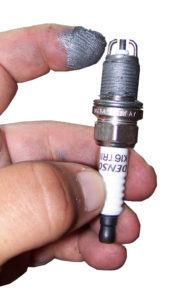
The manufacturers would have to come up with a ton of different torque values for every car (dry and lubricated.) Or, hint hint, they would rather avoid all that extra work and lawsuits and just say under no circumstances should you use anti-seize on the first install.
Also, like many technicians that service fleet vehicles I believe a tiny amount of anti-seize should be used on most bolts, fasteners, and nuts where you suspect they may become rusted or seized up.
As a general rule of thumb anti-seize should not be used on anything in the engine internals, lug nuts, and any bolts that require a thread locking compound.
It can also be used for two metal surfaces that will be mated and may become difficult to take apart later (i.e., hub assemblies, brake rotors, cv axles).
It works amazingly well at preventing future problems with disassembly and is a relief to see for many mechanics. Don’t be alarmed though there are plenty of mechanics who hate the stuff. Especially because auto parts stores and youtube mechanics somehow love spreading the anti-seize gospel and it ends up being used way too much and too often.
Be careful not to put way too much anti-seize on the threads of spark plugs. It is hard to tell in this photo but looks like they’re about to use way too much.
From my research, the two best kinds of anti-seize for general automotive use are the nickel and the aluminum variety
The Nickel based compound outperforms the copper and aluminum-based anti seizes. However, it can be hard to find at your local parts store. That being said the classic aluminum anti-seize should work perfectly well for you. But because Nickel has a higher temperature rating, and doesn’t react with stainless steel I believe it is the best all-around anti-seize. If you only want to buy one kind, then get the best nickel anti-seize here (links to Amazon).
Wet (Lube) VS Dry Torque Values:
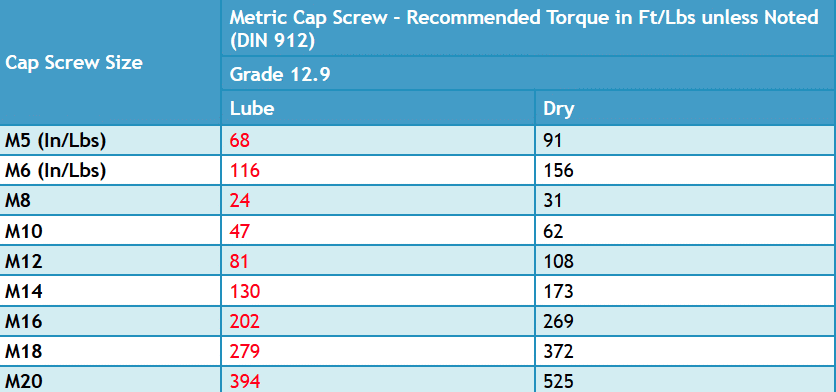
You must understand that anti-seize is a lubricant.
Lubrication means it changes actual torque values. Most torque specs are given assuming a dry fastener unless they specifically say “wet/lubed torque.”
How does this affect a torque wrench? It will actually click at a higher torque with a lubricated bolt (more torque is applied to the fastener).
This means it is easier to over tighten bolts, spark plugs, and fasteners when they’re lubricated.
You must be aware of this and develop a feel for when a spark plug is tight, regardless of whether it is lubricated or not. To the seasoned technician, this is a developed feel. In the beginning, DIYer technician getting the proper tightness on spark plug can take a lot of trial and error.
How to tighten a spark plug without a torque wrench:
If you aren’t experienced installing spark plugs, in general, you need to develop a feel for the correct tightness. I have a pretty fun plan for you and it involves breaking stuff.
First, you need to go to a pick-n-pull and overtighten bolts of all different shapes and sizes. Break stuff. Get a feeling for when something is tight, then push it until it breaks. Especially with spark plugs.
Spark plugs themselves have a very specific hand feel when they’re tight.
Do Automotive Technicians Use Torque Wrenches on Spark Plugs:
Most technicians do not use a torque wrench for spark plugs whether they use anti-seize or not.
My advice to you if you aren’t that experienced with torque values and spark plug installations?
Over tighten spark plugs, remove them and put anti-seize on them and then run them way too tight.
Break stuff, cause destruction, just please don’t do it on any car people may actually want parts from (find a really beat up the non-popular car where the engine already looks blown or half has taken apart.
Feel what it feels like to over tighten plugs. Go past where you know it is tight.
Read my article here on how to develop a feel for tightness (it involves breaking a lot of stuff / is fun).
Therefore, be more careful not to over tighten lubricated bolts.
As a general rule of thumb reduce the torque by around 20% of an oiled bolt versus a dry one. Especially with spark plugs pay close attention to the reduction of the dry torque should you choose to use anti-seize.
However, if you have developed any sort of hand feel for when a spark plug is seated properly this will not change with anti-seize applied. You will still feel it seat and know when it is tight.
This is why NGK and other spark plug makers tell you not to use anti-seize.
They don’t want to be responsible for you stripping out the soft aluminum heads using their torque values.
They also don’t want to have to come up with a ton of different torque values for all the different cars (both wet and dry).
If they just tell you not to use it, then you use it and strip out the head with their torque values they’re not at fault.
If every technician had a good hand feel and was smart, they would say using anti-seize is perfectly safe and a great practice.
Briansmobile1, a professional technician, explains why he chooses to use anti-seize:
Some Mechanics Use Anti-Seize and Swear By It, Others Never Touch It:
It is up to you to come up with your own technique and style.
I am of the group that believes anti-seize used properly will cause zero problems. The keyword here is “properly,” I will discuss how to use it properly below.
And installing spark plugs without anti-seize is potentially catastrophic (at least to your weekend plans and wallet).
Also, the protective coating that these manufacturers say protects you from the plug seizing in the head only works for the first installation. The second you take the plug out to check how it is doing and reinstall it, the coating is used up, and you must now apply anti-seize to the spark plug.
Sound complicated? Yeah. That is why I like to just apply anti-seize from the start following these strict guidelines.
Of all the varieties of anti-seize, you can buy, your safest bet is these two types:
From my research, these are the best reviewed and least likely to cause problems.
- Nickel Based Anti Seize from Motorcraft (links to Amazon)
- Aluminum Variety (links to Amazon) If you only want to buy one type and have it handle everything you need, get the nickel variety.
Why is Nickel my favorite? It will not react with stainless steel (copper will) and also works at extremely high temperatures.
Parts of a car that are made with stainless steel and will react with Copper based anti seize —
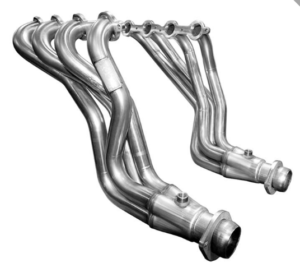
A lot of exhaust components / also aftermarket headers/mufflers etc
High-quality fasteners are used in racing applications.
Why take a chance? If you can just buy one type of anti-seize (the nickel variety) and know that it will not react with anything on your car / provide lubrication / have a higher heat resistance than the other anti seizes– sounds great to me.
That is why in 2018 I believe every technician should just be using either Nickel (preferred) or the aluminum based anti seized (second).
Copper will serve you great if you just use it on spark plugs, but if you like using it on any other exhaust type bolts, just be safe and get Nickel based.
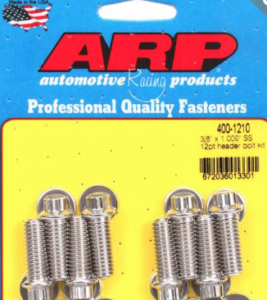
Therefore, you can slap it on pretty much anything on a car without worrying about it reacting poorly. Not true of Copper based anti seize, and Copper makes its way into a lot of the formulas of different anti seizes (even if they don’t say copper on the label).
Drawback? It is a little more expensive. Also slightly more toxic to you with prolonged skin exposure.
You wear gloves though anyway! Right? RIGHT?! 🙂
Copper VS Nickel VS Aluminum What Is The Best Anti Seize?
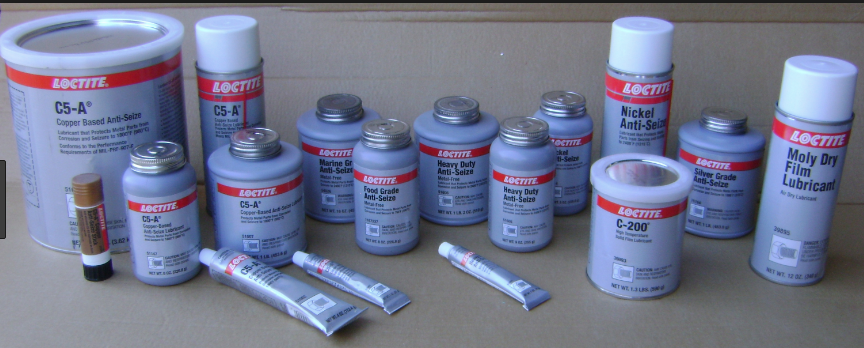
This question has been debated for thousands of hours on the internet.
Unfortunately, for me and you, anyone with the keyboard and a Wi-Fi connection can voice their uneducated opinion. The real technicians that have thousands of hands-on hours get drowned out by the armchair mechanics with 80 words per minute typing speed.

It also doesn’t help that anti-seize comes in like 40 different compositions all marketed aggressively. Most by eager for your money chemical companies.
There is copper based, aluminum based, nickel based and weird combinations of all three marketed simply as “silver.”
Will most of these all work perfectly well for automotive applications? Yeah.
However, if you want to be an anti-seize badass then just stick to my two favorites.
First, the most common and time tested (Permatex Aluminum):
Pros:
- Cheap and easy to find at chain automotive stores / Mom n Pop shops as well.
- Will last you a lifetime if you buy the jar like this.
- Has a good heat rating, and will not react with Stainless Steel like Copper anti seize will.
- A totally okay anti seize for most people’s needs.
Cons:
- Has a lower heat rating than both Copper anti seize and Nickel based anti seize (my favorite.
Why Nickel Based Anti-Seize Is The Best For Automotive Use:
What is the difference between a Nickel based Anti Seize and Aluminum?
Well, right there is your answer. One has bits of Nickel to keep the threads for seizing, and the other has bits of aluminum (usually other compounds as well including Copper).
Yes, this a very simplified answer, if you want to read more about the different types click here.
Granted that link is from a manufacturer of anti-seize and it doesn’t really simplify anything because they want you to buy a different product for every application.
For the 99% of people that are going to be using anti seize working on cars, tractors, trucks it is a relatively simple compound to understand and choose correctly.
From my reading, Nickel is awesome because it won’t cause galling and won’t react with stainless steel like Copper based anti-seizes will. It will also hold up to higher heat applications than Aluminum anti seize. If you’re only going to buy one type, buy this one (links to Amazon to check price).
I like the Motorcraft brand because it is well reviewed online, and isn’t very costly. To check the current price on Amazon click here.
Most auto parts stores do not carry a Nickel based anti seize. They will have lots of different types and brands, all of which will probably work perfectly well for you, but in order to be safe, I think the Nickel just covers all the bases.
What Do Aircraft Engineers and Engine Manufacturers Say About Anti Seize?
I love looking to aviation to support my theories with anything that has a crossover in the automotive world.
Guess what? A lot of private planes all have engines very similar to cars and trucks.
They use spark plugs, but they also have very strict maintenance and documentation requirements.
Has the topic of anti seize also has been debated in the aviation world? Yes.
Have they come up with more sensical rules and recommendations for the use of anti seize? Yes.
Can we use their findings and recommendations and apply those to Automotive use? I see no reason why not.
According to Aircraft Technicians and Engineers On Application of Anti Seize:
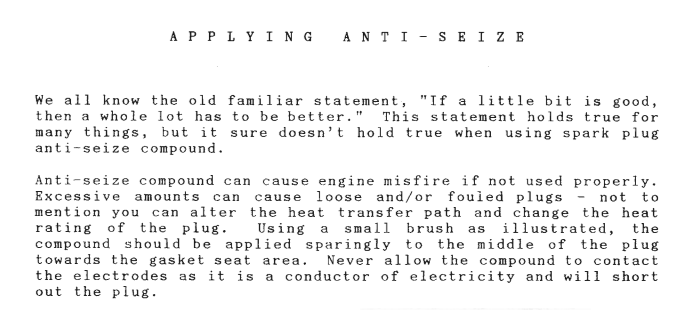
For a more recent take check out this TB published in 2011 by Tempest Aero:
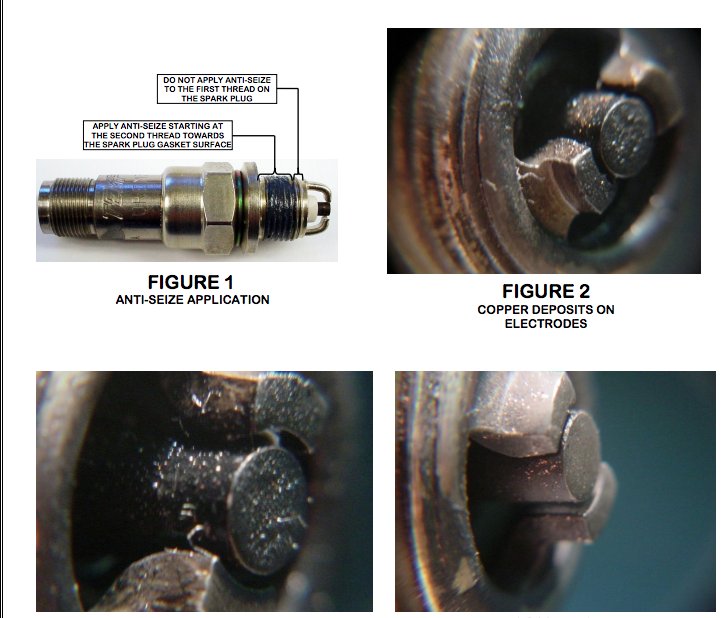
From My Research Here Is My Guide In 2018 To Using Anti Seize:
- Select the right kind for your application (heat, pressure, type of metals)
- Once again I recommend the Nickel based type since it does not react with Stainless steel (unlike the Copper based anti seize)
- It also has a higher temperature rating than the Aluminum variety (Nickel goes up to 2400 degrees Fahrenheit / Aluminum only goes to 1600). Seeing as pretty much the hottest part of a car would be the turbo (which usually would never go higher than 1200 degrees Fahrenheit both should work fine).
- Both Nickel and Aluminum conduct electricity so the argument that anti seize leads to plugs not being able to ground properly is also simply false.
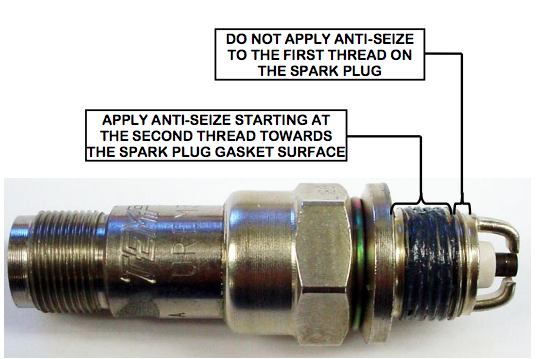
- Do not apply a lot. A little goes a long way.
- Apply it in the middle of the threads of the Spark Plug (do not apply it near the electrode end)
- Be careful torquing the Spark Plugs down, realizing that it is easier to over tighten a lubricated spark plug.
- Enjoy being able to get the spark plugs out easily 80,000 miles down the road!
Other ways to use anti-seize correctly (a tiny amount):
There are tons of other applications for anti seize when you’re working on cars, here are some of my favorites:
- Brake Caliper Hanger Bolts (Make sure to Torque Correctly. A tiny bit of anti seize goes a long way).
- Exhaust Bolts / Turbo Bolts / Anything that gets super hot / cools down. Very prone to rust/freezing up.
- When starting hard-to-reach bolts and I want to be sure they go in easily. A touch of grease also works or dipping the bolt in engine oil (new or used).
- Water pump bolts (notorious for breaking especially on Alfa Romeo’s / VW’s / and many others)
- Tons more applications. It is literally a must-have in any competent mechanics toolbox. For every application, there are going to be people that say not to use it, and others that say they use it everyday with no problems. It is up to you to form your own educated opinion and go from there.
- I do not claim to be an expert in this field. I am simply compiling all the research I have found, and digesting it so that for you it can be easier to understand.
Here is briansmobile1 talking about why using anti seize will be good karma for you in the future:
As A Reminder Do NOT Use Anti-Seize On The Following Applications:
- When the manual for the car calls for oil on the threads then you should use more motor oil as specified by the factory service manual. For example, when reinstalling head bolts on a Subaru EJ25 engine it specifically calls for oiling the threads. Do not use anti-seize instead. Just follow the instructions/torque values they call for.
- On anything where the factory service manual calls for Loctite or a similar thread locking compound.
- In that case, you should clean the threads thoroughly with brake clean or acetone to make sure there is a clean bonding surface.
- This should be obvious but do not use it where gaskets will be mating onto surfaces. For example, do not coat a water pump gasket in anti-seize so that it’ll be easier for you to remove later.
- Als,o I have read that you should not use anti-seize if you have a time cert installed. If anything use a drop of oil on the threads.
Basically, with time and experience, you will learn to use anti-seize safely and effectively.
If cars come back to you for repeat maintenance, or not, you will see how it pays forward to keep things from seizing up.
This is the end of all article on anti seize. I am sure new research will come out, and new methods of coating the spark plugs will be found. Anti seize may very well be on its way out.
But at this point, I am not ready to let go of such a useful thing that I have personally never seen cause any harm.
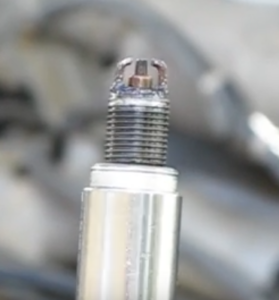
I have only seen the opposite be true, like this video I made with my Toyota Tundra with 360,000 miles on it. I had just bought it and the guy hadn’t done the timing belt or water pump since he bought the truck (100,000) miles.
When he had done the plugs, they were the correct plugs and they were the ones with the coating on them that is supposed to make them not stick. Well, here you can see me battling them hard.
Also, yes in the video I did not use anti-seize, I used grease. I mumble “don’t follow my lead.”
I had just had all my tools stolen, and was doing repairs on the cheap (plus it was my truck).
This truck now has 370,000 miles on it and it will probably never get new spark plugs before the engine fails.
So, I wasn’t really worried too much about it.
Like many things in car repair, there is the right way to do it. Then there is the way it gets done 90% of the time and still works fine.
As always stay safe. Get dirty. And keep your friends and family safe.
If you want to buy the best Nickel based anti seize I found online– click here to check the price on Amazon.
What do some technicians have to say on forums/Facebook about anti-seize?
I compiled a bunch of screenshots of people debating this topic I used to help guide my article.
They’re great reading if you want even more information. I hope you enjoy them!

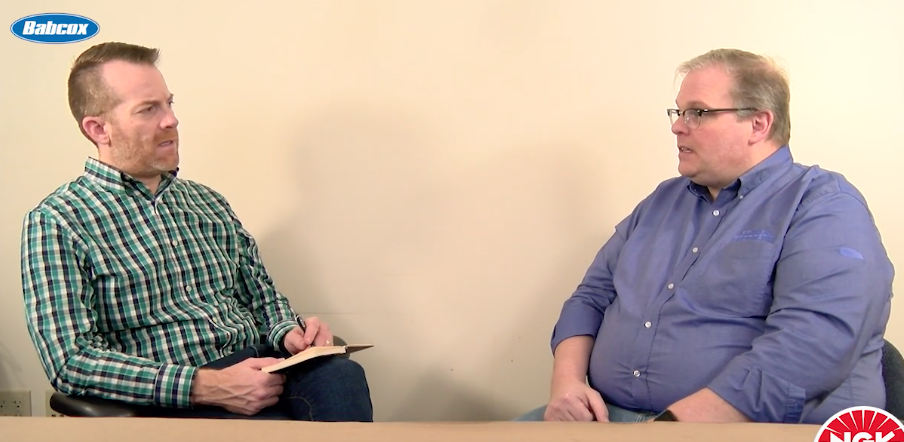
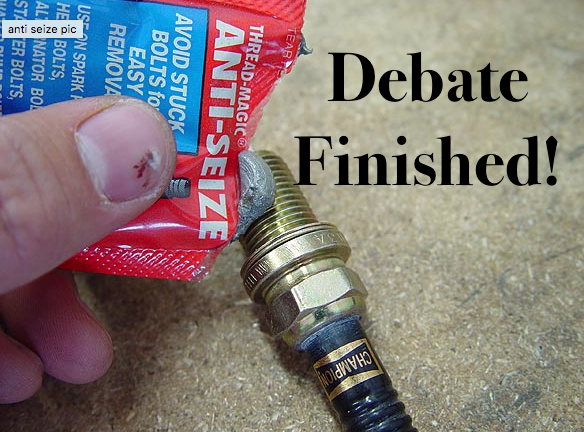
Hey! You made it this far if you want to check out my list of top ten cool automotive tools click here. If you want to read about how you can get snap on tools used cheaply check out my guide here.
Thanks for reading!
** New in 2019, mechanics voted on their favorite tool inventions that have made car repair easier here.

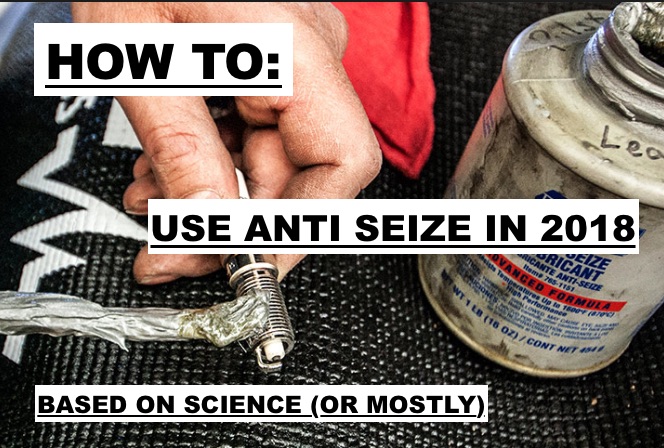
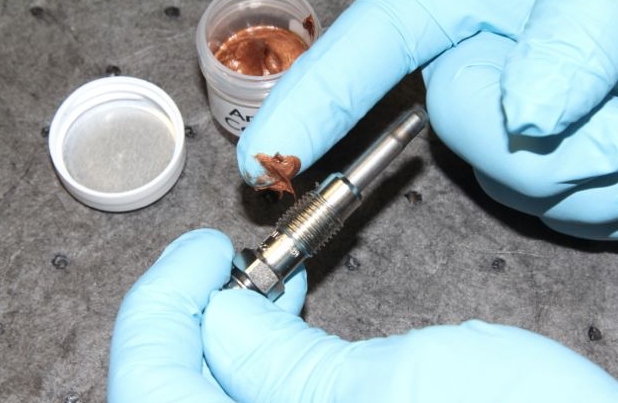

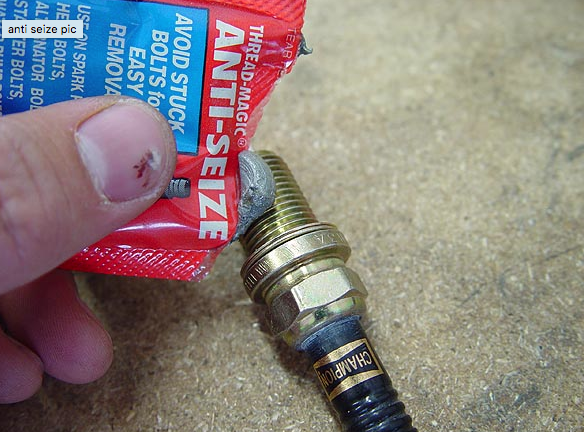
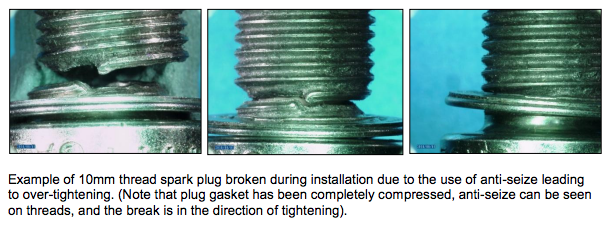

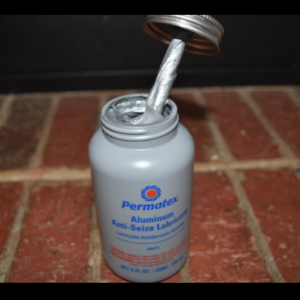
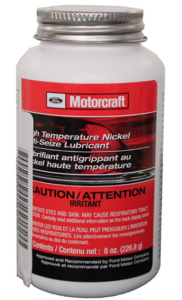

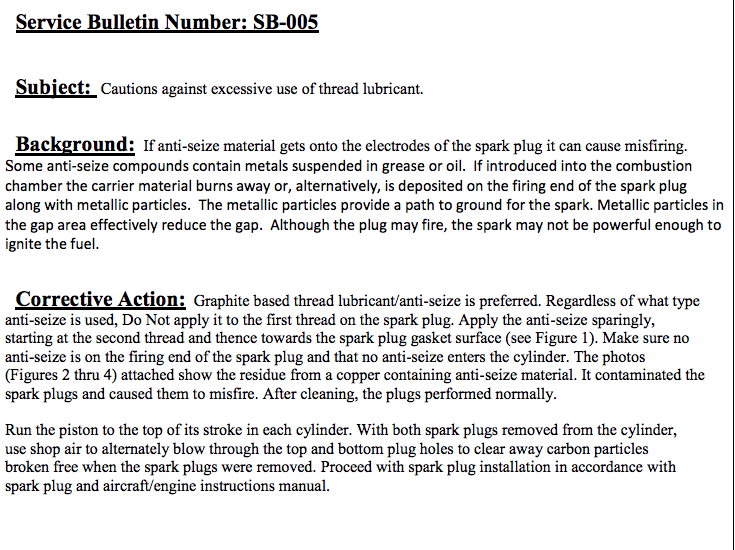




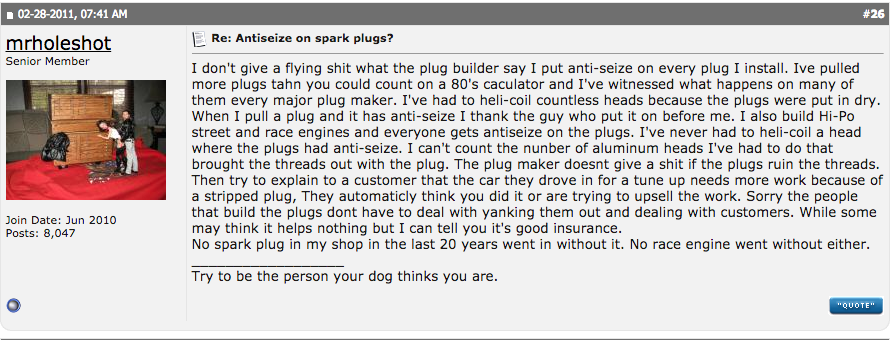






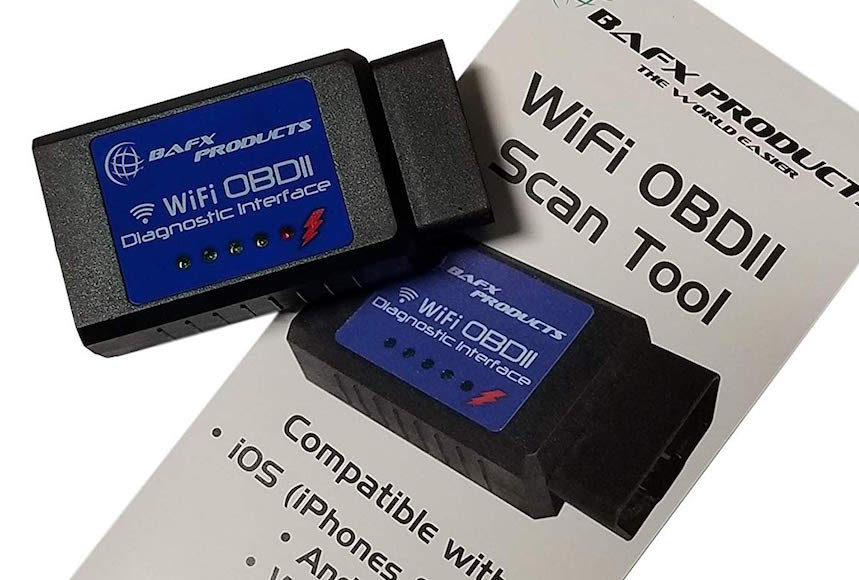
Pingback: Old School Mechanic Tips (10+) Everyone Should Know - AGradeTools.com